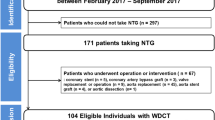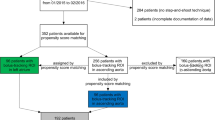Abstract
The present study investigated angiographic emulation of multislice computed tomography (MSCT) (catheter-like visualization) as an alternative approach of analyzing and visualizing findings in comparison with standard assessment. Thirty patients (120 coronary arteries) were randomly selected from 90 prospectively investigated patients with suspected coronary artery disease who underwent MSCT (16-slice scanner, 0.5 mm collimation, 400 ms rotation time) prior to conventional coronary angiography for comparison of both approaches. Sensitivity and specificity of angiographic emulation [81% (26/32) and 93% (82/88)] were not significantly different from those of standard assessment [88% (28/32) and 99% (87/88)], while the per-case analysis time was significantly shorter for angiographic emulation than for standard assessment (3.4 ± 1.5 vs 7.0 ± 2.5 min, P < 0.001). Both interventional and referring cardiologists preferred angiographic emulation over standard curved multiplanar reformations of MSCT coronary angiography for illustration, mainly because of improved overall lucidity and depiction of sidebranches (P < 0.001). In conclusion, angiographic emulation of MSCT reduces analysis time, yields a diagnostic accuracy comparable to that of standard assessment, and is preferred by cardiologists for visualization of results.


Similar content being viewed by others
References
Dewey M, Borges AC, Kivelitz D et al (2004) Coronary artery disease: new insights and their implications for radiology. Eur Radiol 14:1048–1054
Nieman K, Cademartiri F, Lemos PA, Raaijmakers R, Pattynama PM, de Feyter PJ (2002) Reliable noninvasive coronary angiography with fast submillimeter multislice spiral computed tomography. Circulation 106:2051–2054
Ropers D, Baum U, Pohle K et al (2003) Detection of coronary artery stenoses with thin-slice multi-detector row spiral computed tomography and multiplanar reconstruction. Circulation 107:664–666
Mollet NR, Cademartiri F, Nieman K et al (2004) Multislice spiral computed tomography coronary angiography in patients with stable angina pectoris. J Am Coll Cardiol 43:2265–2270
Dewey M, Laule M, Krug L et al (2004) Multisegment and halfscan reconstruction of 16-slice computed tomography for detection of coronary artery stenoses. Invest Radiol 39:223–229
Dewey M, Teige F, Schnapauff D et al (2006) Noninvasive detection of coronary artery stenoses with multislice computed tomography or magnetic resonance imaging. Ann Intern Med 145:407–415
Cademartiri F, Mollet N, Lemos PA et al (2004) Standard versus user-interactive assessment of significant coronary stenoses with multislice computed tomography coronary angiography. Am J Cardiol 94:1590–1593
Dewey M, Schnapauff D, Laule M et al (2004) Multislice CT coronary angiography: evaluation of an automatic vessel detection tool. Fortschr Röntgenstr 478–483
Blobel J, Baartman H, Rogalla P, Mews J, Lembcke A (2003) Räumliche und zeitliche Auflösung für die Herzdiagnostik mit 16-Schicht-Computertomographie. Röfo 175:1264–1271
Austen WG, Edwards JE, Frye RL et al (1975) A reporting system on patients evaluated for coronary artery disease. Report of the Ad Hoc Committee for Grading of Coronary Artery Disease, Council on Cardiovascular Surgery, American Heart Association. Circulation 51:5–40
Hawass NE (1997) Comparing the sensitivities and specificities of two diagnostic procedures performed on the same group of patients. Br J Radiol 70:360–366
Bland JM, Altman DG (1986) Statistical methods for assessing agreement between two methods of clinical measurement. Lancet 1:307–310
Khan MF, Wesarg S, Gurung J et al (2006) Facilitating coronary artery evaluation in MDCT using a 3D automatic vessel segmentation tool. Eur Radiol 16:1789–1795
Koch K, Oellig F, Oberholzer K et al (2005) Assessment of right ventricular function by 16-detector-row CT: comparison with magnetic resonance imaging. Eur Radiol 15:312–318
Dewey M, Müller M, Teige F, Hamm B (2006) Evaluation of a semiautomatic software tool for left ventricular function analysis with 16-slice computed tomography. Eur Radiol 16:25–31
Hoffmann MH, Shi H, Schmitz BL et al (2005) Noninvasive coronary angiography with multislice computed tomography. JAMA 293:2471–2478
Kefer J, Coche E, Legros G et al (2005) Head-to-head comparison of three-dimensional navigator-gated magnetic resonance imaging and 16-slice computed tomography to detect coronary artery stenosis in patients. J Am Coll Cardiol 46:92–100
Zorzetto M, Bernardi G, Morocutti G, Fontanelli A (1997) Radiation exposure to patients and operators during diagnostic catheterization and coronary angioplasty. Cathet Cardiovasc Diagn 40:348–351
Cusma JT, Bell MR, Wondrow MA, Taubel JP, Holmes DR Jr (1999) Real-time measurement of radiation exposure to patients during diagnostic coronary angiography and percutaneous interventional procedures. J Am Coll Cardiol 33:427–435
Gerber TC, Stratmann BP, Kuzo RS, Kantor B, Morin RL (2005) Effect of acquisition technique on radiation dose and image quality in multidetector row computed tomography coronary angiography with submillimeter collimation. Invest Radiol 40:556–563
Trabold T, Buchgeister M, Kuttner A et al (2003) Estimation of radiation exposure in 16-detector row computed tomography of the heart with retrospective ECG-gating. Röfo 175:1051–1055
Leschka S, Alkadhi H, Plass A et al (2005) Accuracy of MSCT coronary angiography with 64-slice technology: first experience. Eur Heart J 26:1482–1487
Leber AW, Knez A, von Ziegler F et al (2005) Quantification of obstructive and nonobstructive coronary lesions by 64-slice computed tomography: a comparative study with quantitative coronary angiography and intravascular ultrasound. J Am Coll Cardiol 46:147–154
Pugliese F, Mollet NR, Runza G et al (2006) Diagnostic accuracy of non-invasive 64-slice CT coronary angiography in patients with stable angina pectoris. Eur Radiol 16:575–582
Raff GL, Gallagher MJ, O’Neill WW, Goldstein JA (2005) Diagnostic accuracy of noninvasive coronary angiography using 64-slice spiral computed tomography. J Am Coll Cardiol 46:552–557
Ropers D, Rixe J, Anders K et al (2006) Usefulness of multidetector row spiral computed tomography with 64- × 0.6-mm collimation and 330-ms rotation for the noninvasive detection of significant coronary artery stenoses. Am J Cardiol 97:343–348
Mollet NR, Cademartiri F, van Mieghem CA et al (2005) High-resolution spiral computed tomography coronary angiography in patients referred for diagnostic conventional coronary angiography. Circulation 112:2318–2323
Johnson TR, Nikolaou K, Wintersperger BJ et al (2006) Dual-source CT cardiac imaging: initial experience. Eur Radiol 16:1409–1415
Author information
Authors and Affiliations
Corresponding author
Rights and permissions
About this article
Cite this article
Schnapauff, D., Dübel, HP., Scholze, J. et al. Multislice computed tomography: angiographic emulation versus standard assessment for detection of coronary stenoses. Eur Radiol 17, 1858–1864 (2007). https://doi.org/10.1007/s00330-006-0540-7
Received:
Revised:
Accepted:
Published:
Issue Date:
DOI: https://doi.org/10.1007/s00330-006-0540-7




